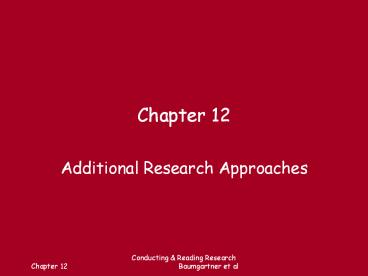Conducting%20 - PowerPoint PPT Presentation
Title:
Conducting%20
Description:
Test physical and chemical properties of items to confirm age, authorship. Test signature, script, handwriting, spelling, and type to ... Creative Activities ... – PowerPoint PPT presentation
Number of Views:26
Avg rating:3.0/5.0
Title: Conducting%20
1
Chapter 12
- Additional Research Approaches
2
Historical Approach
- Goal Record and understand events of the past
- Problems
3
Sources of Historical Data
- Primary sources
- original documents, physical artifacts, people
who were eyewitnesses - Secondary sources
- textbooks, newspapers, abstracts, almanacs,
encyclopedias, bibliographies (some of these may
sometimes be primary sources)
4
Evaluating Historical Data
- criticism
- Test physical and chemical properties of items to
confirm age, authorship - Test signature, script, handwriting, spelling,
and type to confirm authenticity - Check consistency in language use, time-sensitive
knowledge and technology - criticism
- Assess meaning and content of item
- Assess value of data
5
Oral History - Techniques
- Taped history should also be writted and edited
by primary source - Content should use researchers notes as must as
possible - Questioning must be conducted carefully (no
leading questions) - Interview sessions should be short
- Topics should be given to interviewee in advance
- Researcher should be well-read in topic
6
Biographical Research
- Humanizes past
- Use lots of primary sources
- Difficulties
- May or may not be testing a hypothesis
7
Epidemiological Approach
- Descriptive identify patterns, trends, etc.
- May attempt to determine causation
8
Research designs
- Cohort studies ( studies)
- Case-control studies ( studies)
9
Ten Principles of Causal Inference
- Strength of Association
- Dose-Response Relationship
- Independence
- Temporal Sequence
- Persistence
- Alterability
- Agreement
- Consistency
- Biologic Plausibility
- Experimental Confirmation
10
Strength of Association
- Relative Risk likelihood that a group with a
risk factor will have a health characteristic in
comparison to a group without risk factor - Odds-ratio Estimate of relative risk
- Attributable Risk Percentage of cases in the
total group that occur in the group with a risk
factor.
11
Single Participant Approach
- May include more than one subject
- Baseline measure obtained for each participant,
compared to post-treatment score - Do not analyze data as group, based on idea that
some treatments may work only in some individuals
12
Creative Activities
- Examples dance, skillful performers, development
of novel computer programs for various purposes,
gymnastics, development of new piece of equipment
or new procedure































